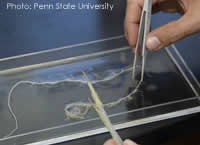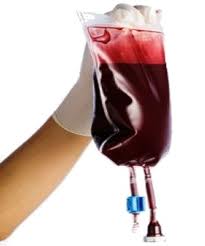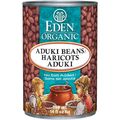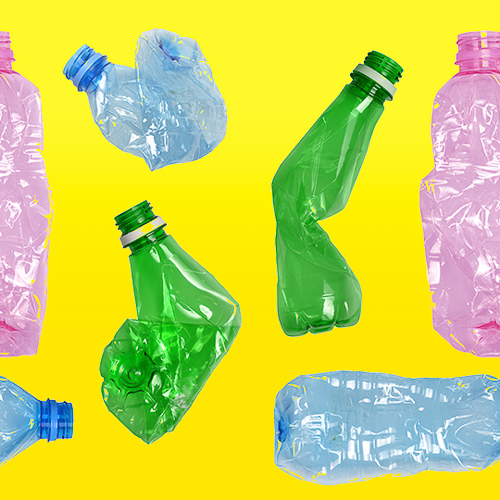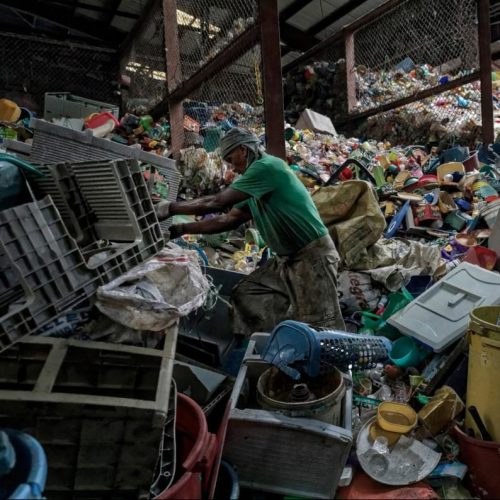8 January 2009 — Plastic Additives Leach into and Skew Medical Experiments — Medical researchers from the University of Alberta have found that disposable plasticware commonly used in scientific experiments leach two types of chemicals that affect and can even ruin the results of experiments. Oleamide (a lubricating agent added to the plasticware) and quaternary ammonium biocides (anti-bacterial agents also added to the plastic) were found to leach from the plastic. Certain of the compounds were also found to biologically interact with, and change the behaviour of, human enzymes and brain receptors in different experiments.
Plastics and Breast Cancer
11 September 2010 — Plastics can cause or contribute to breast cancer. Our dear friend Janet has breast cancer and we can’t help but wonder if some plastic chemicals have played a role in the development of her disease. When she was first diagnosed, she had stage 3 breast cancer in 2005 and was still breastfeeding her 6 month old son. Stage 3 means that although her cancer had not spread to other organs, some cancerous cells had been found in her lymph nodes. She immediately had her right breast surgically removed and started chemotherapy. Two years later, her cancer progressed to stage 4 when metastases were found in her lungs. After treatment her cancer went into short remission and then last summer, a tumour was found in her brain. As she puts it, she “tripled” her prognosis and one year later leads a very full and active life. She continues to be very involved on the advocacy front, trying to help traditional medicine embrace a more holistic approach toward cancer.
Plastic Residue from Blood Bags End Up in Blood Stream
10 October 2010 — A friend of ours who is a major cycling fan sent us this news story about Alberto Contador, the Spanish cyclist who won the Tour de France this summer (and last year). Apparently he is suspected of having used the performance-enhancing drug called clenbuterol through intravenous supply. He says that it is through food cross-contamination that traces of the drug ended up in his bloodstream. However, along with traces of the drug, officials also found “traces of a plastic residue the same as the type used to manufacture blood bags”. So he is probably lying…
Canned Food You Can Trust – A list of BPA-Free Lining Canned Products
We continually hear about how bad bisphenol A (BPA) is for everybody and particularly for infants and pregnant women. The evidence is there. For those still skeptical, the precautionary principle dictates that you should be cautious. It is mind boggling that the food industry is so slow to remove BPA from the lining of food cans. Fortunately, some food companies understand the problem and have switched to non-BPA linings for their cans. They do not necessarily advertise this fact on their cans, so you need to memorize this list! Here they are:
1) Eden Food: They have been using BPA-free linings in their cans for more than 10 years! How visionary! Although the cans cost 14% more, the company feels it is worth it. I think so too. While Jay and I generally avoid buying canned food because of BPA, we are happy to indulge in a good vegetarian chili with non-BPA canned beans once in a while. Unfortunately, Eden’s tomatoes are still offered in BPA-lined cans because of the acidic nature of tomatoes… So try and find a brand of tomatoes packaged in a glass jar. This is especially important because acidic food increases the deterioration of the BPA lining and thus increases its leaching.
Replacing Your Polycarbonate 5 Gal Bottle with A Snazzy Italian Stainless Steel Water Dispenser
While there is more and more recognition of the toxicity of Bisphenol A (“BPA” found in polycarbonate plastic — even the FDA agrees with this) to human health and the environment, it is still extremely difficult to find a healthy alternative to the widely used 5 gallon large polycarbonate water bottle. We used to sell a glass 5 gallon bottle as a replacement, but it is extremely heavy when filled with water and difficult to transport. Then last year we discovered stainless steel water dispensers made in Italy. They are high quality, light weight, watertight and they can be used with or without a spigot. Perfect for transporting and dispensing water. We used to carry theSuperfustinox but we have since changed to a different brand, Sansone, which is butt welded instead of being seam folded.
These dispensers are made of really high quality food grade stainless steel 18-10 and they are beautiful. We currently carry the cute 3 litre (0.8 gallon) for the fridge or to bring in the car on a road trip. The 5 litre (1.3 gallon) which is a perfect counter companion. The 10 litre (2.6 gallon) for camping and the 30 litre(7.9 gallon) for serious water transportation and dispensing. Last summer we brought our large water dispenser when going to the beach for the day. It was perfect. Easy to carry and the kids could just dispense their own water whenever they were thirsty.
The Disappearing Male — A Documentary to Watch
3 July 2009 — I recently discovered an extremely troubling documentary on the effects of endocrine disrupting chemicals, notably phtalates, Bisphenol A and brominated flame retardants (PBDEs) which are widely found in plastics, on the male population. These chemicals are said to affect males more directly than females because they cause an hormonal imbalance in the mother’s womb at the time when male reproductive organs are being formed.
One sad example is the Aamjiwnaang First Nation community near Sarnia, Ontario, Canada where the proportion of male live births has been declining continuously since the early 1990s from an apparently stable sex ratio of 50%.
India Rising… Above Plastic
We are just back from a trip to “Incredible !ndia” — this is the tag line used by the Indian Ministry of Flower vendorTourism to promote India around the world, and it’s true, India is !ncredible. One might argue that I’m biased because I have Indian roots, but this is a country that grabs everyone by all senses and flys away with you. It is so alive, just teeming with life. And the colours – I love the flowers sold in the street, and the numerous fresh vegetable stands.
We were there to visit family and meet with some of our suppliers. We visited Mumbai, Kolkata and Delhi. Doing what we do, Chantal and I were always on the lookout for signs and info about the current state of the plastic pollution in India, and what is being done about it. With a population exceeding a billion, over 30% of which live below the poverty level, dealing with plastic waste is a challenge by any measure. And yet, we found many signs of positive action.
Public Schools in Maryland Buy BPA Trays for Children
18 February 2009 — I just discovered today a news piece about a school board in Elkridge Maryland agreeing to spend $45,924 to purchase 10,320 compartmented trays made of polycarbonate plastic (the kind that contains BPA) to be used by school children. I am disappointed that the science behind the dangers of this type of plastic is still not fully accepted, therefore putting thousands of children at risk. As I understand it, these trays will be used like a plate and will be in contact with food.
Plastic Realities
The evidence is growing that chemicals leached from plastics used in everyday life, including for cooking and food & drink storage, are harmful to human health. Among the most disturbing of these are hormone – aka endocrine – disrupters, such as Bisphenol A (BPA). BPA has been associated with increased risk for cardiovascular disease, miscarriages, breast and prostate cancer, reproductive dysfunction, metabolic dysfunction and diabetes, and neurological and behavioral disorders. The health risks of plastic are significantly amplified in children, whose immune and organ systems are developing and are more vulnerable.

